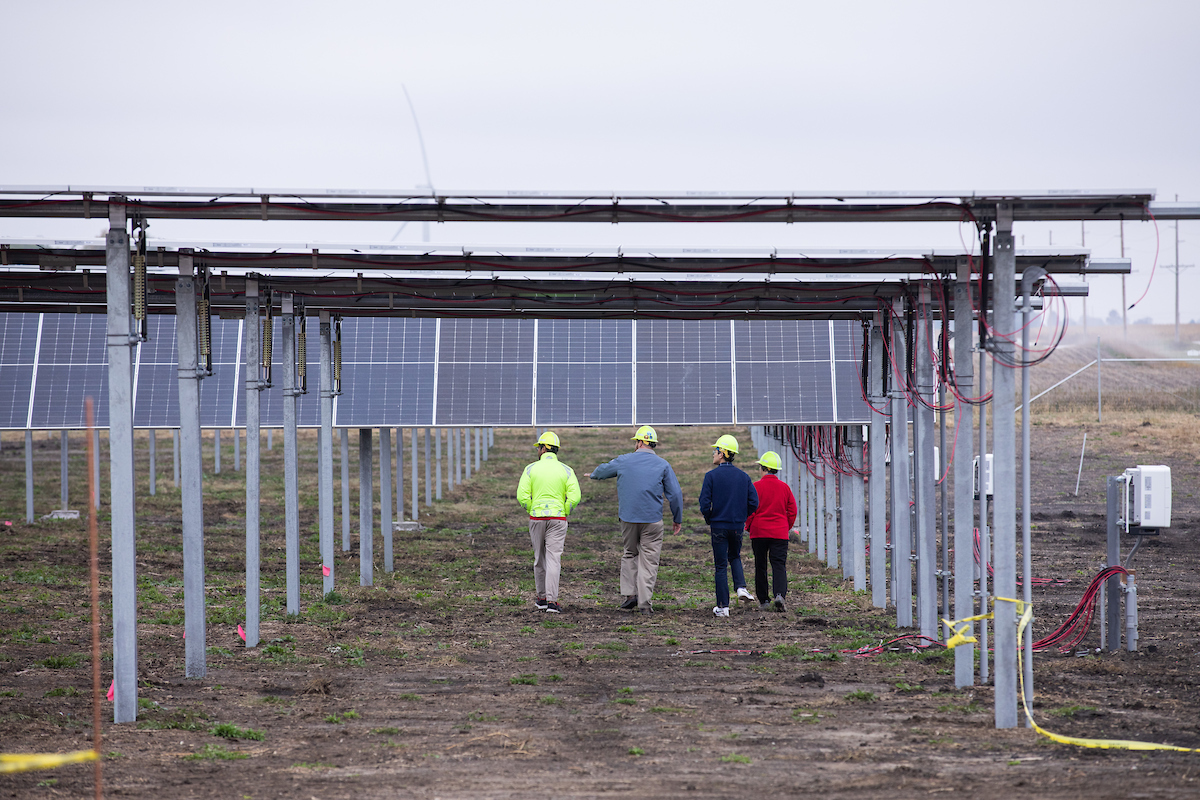
Iowa State engineers are working to make the power grid better at integrating renewable power plants, such as the Alliant Energy Solar Farm at Iowa State University. Larger photo. Photo by Christopher Gannon/Iowa State University.
AMES, Iowa – If you’re the Midcontinent Independent System Operator – the organization that manages the flow of high-voltage electricity across a central stripe of the U.S. and Canada, from Manitoba, Michigan and Minnesota through Iowa and all the way to Louisiana – you want energy supplies to meet the energy demands of 45 million people.
“We make sure the right amount of electricity is generated and transmitted to our member utilities,” says the regional grid operator’s website.
Balancing power supply and demand is complicated these days. Electricity is no longer exclusively generated by power plants using coal- or natural gas-powered turbines spinning away at known capacities and ramped up or down according to customer demand.
Now there are very different kinds of power plants producing electricity. There are all the wind farms across Iowa, for example, that now produce more than 64% of the state’s electricity. And there are solar operations such as the new Alliant Energy Solar Farm at Iowa State University, a new power generator and agricultural research project just south of Ames.
All those power plants fueled by renewables raise new challenges for grid operators and utilities.
“You can’t control the sunshine; you can’t control the wind speed,” said Zhaoyu Wang, a Northrop Grumman associate professor of electrical and computer engineering at Iowa State who’s affiliated with the university’s Electric Power Research Center. “But the power system wants certainty.”
Wang’s research specialty is working to modernize electric grids for better, more reliable energy flow. The latest project he’s leading, in fact, is called “MODERNISE,” for “Modernizing Operation and Decision-Making Tools Enabling Resource Management in Stochastic Environment.”
The U.S. Department of Energy (DOE) announced last month it has selected the project for a three-year, $3 million grant, pending final negotiations. A cost-share of an additional $1.1 million, including in-kind contributions of labor and equipment, will be provided by project collaborators.
Institutional collaborators include Argonne National Laboratory, the National Renewable Energy Laboratory, PJM Interconnection (a regional transmission organization based in Pennsylvania), AES Indiana and AES Ohio (utility companies), Siemens Corp., and Hitachi America Ltd. ISO New England (a regional transmission organization) and the Tennessee Valley Authority (a federally owned utility and development corporation) are project advisors.
In addition to Wang, other Iowa State electrical engineers working on the project include Bai Cui, an assistant professor and project coleader, and Salish Maharjan, a postdoctoral research associate.
The MODERNISE project is part of a $34 million investment by the DOE's Solar Energy Technologies Office supporting 11 new projects developing “tools to advance a clean, reliable electricity grid run on wind and solar energy,” according to an agency announcement.
“We can’t deploy clean energy if we can’t get renewable sources connected onto our grid,” Jennifer M. Granholm, the U.S. secretary of energy, said in the announcement.
Wang said MODERNISE will produce computational algorithms that allow grid operators to take renewable energy sources – from rooftop solar panels to multi-acre solar farms – and combine them for better grid operations.
“We’re aggregating small, distributed energy resources to larger ones,” Wang said. “We’re using this aggregation capability to improve the transmission grid.”
Those aggregations can help grid operators regulate frequency, voltage, peak demand and importantly, balance supply and demand in real time, Cui said.
“By aggregating these renewable resources, we’re able to help operators better understand the uncertainties of supply,” Wang said. “Putting together a lot of renewables smooths out the uncertainty. There’s more predictability.”
Cui said the researchers will also develop other algorithms that will help operators of bulk power systems integrate the supply of aggregated renewables. That can make grid operations more reliable and efficient.
Wang and Cui said the new tools will help create a modern grid that’s smart and flexible enough to harness renewable electricity from far and wide and get it wherever and whenever customers need it.
Contacts
Zhaoyu Wang, Electrical and Computer Engineering, 515-294-6305, wzy@iastate.edu
Bai Cui, Electrical and Computer Engineering, 515-294-8057, baicui@iastate.edu
Mike Krapfl, News Service, 515-294-4917, mkrapfl@iastate.edu
Quote
“By aggregating these renewable resources, we’re able to help operators better understand the uncertainties of supply. Putting together a lot of renewables smooths out the uncertainty. There’s more predictability.”
Zhaoyu Wang, Electrical and Computer Engineering
Quick look
Solar and wind power plants are unpredictable sources of electricity. That makes integrating them to the power grid a challenge for grid operators. With the help of a U.S. Department of Energy grant, Iowa State engineers are working to create a modern grid that's smart and flexible enough to efficiently distribute renewables.